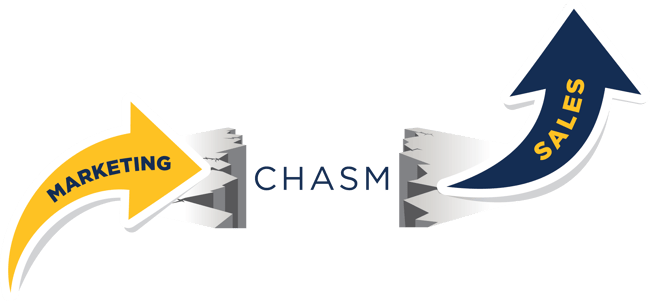
It sounds so promising. Create compelling content (consistently). Share and promote the content. Prospects engage, download stuff and become qualified leads.
Those leads are passed on to the sales team, who instantaneously reach out and are immediately welcomed into the prospect’s world. The meeting quickly turns into a bona fide sales opportunity. Proposals are requested, immediately acted upon and sales are made.
Sure, that scenario may be a little bit overstated, but isn’t this story the fundamental promise of inbound marketing? All of the data and statistics shared by inbound marketing practitioners talk of increased lead generation, lower costs per lead and higherROIs.The answer to the question is a qualified, “Yes.”Inbound marketing is instrumental in building predictable, sustainable and scalable sales growth, but it does not solve the entire problem.
The Chasm Between Leads and Sales
There’s a chasm that exists between sales and marketing. While effective inbound marketing does drive a higher volume of leads and qualified leads, that doesn’t mean that these leads are sales ready when they’re created.

Additionally, the very nature of inbound means that many of the leads you create, while qualified, won’t naturally move into a buying cycle with you. Gleastner Research identified that as many as 80% of the leads you create are caused because someone was looking for valuable content to answer a question or to solve a problem… not because they wanted to buy something.
What makes the chasm so nasty is that unless you have the right tools in place to manage and measure it, it is invisible to most executives. They can see that leads are being created, and they can see that the investment isn’t translating into high volume sales success. The phenomena is the primary reason that research done by CEB found that 87% of the words used by sales and marketing professionals in one discipline to describe the other are negative.
This chasm has two adverse consequences:
- The marketing function is often undervalued (or even overlooked), put off to the side to work on case studies, trade shows and “arts and crafts.”
- Far too much of the weight and pressure falls on the sales team. This was fine years ago when prospects needed to talk with sales people, differences between offers were clear and life was much simpler. Today, the world of sales is simply too complex to be left to the sales team alone.
Sales Development Is The Answer
Here’s the truth about inbound leads: they’re not ready to buy. I recently heard someone describe the value of inbound marketing as:
Rather than you having to go out and interrupt people with your message, the people who you want to do business with will find you. Because they download something you know they’re interested and they’re highly likely to buy from you.
The only truthful part of that statement is the first sentence. Inbound means you can stop using interruption as your primary lead generation tactic. But, the vast majority of inbound leads are not ready to buy, and when they get turned over to the sales team as if they are, bad things happen.

Sales development is the discipline that ensures that leads (of all types) are managed effectively. Your sales team stays focused on their highest value actions – managing and winning new sales.
What is sales development? Trish Bertuzzi, found of The Bridge Group, defines it as the combination of data analysis tools, email nurturing and phone prospecting teams in a specialized role that is exclusively focused on creating sales qualified leads and preparing them for new sales people.
The sales development discipline is the missing piece that ensures alignment between marketing and sales. By properly managing marketing qualified leads (MQLs) and giving the personalized attention to move prospects through the funnel to maximize conversion opportunities, sales development bridges the chasm.
The Need for a Third Discipline
Sales Development and Inbound Marketing are (or should be) kindred spirits. They both rely on data, process and clarity to be successful. They’re designed to work the way customers manage decisions today and reinforce one another.
I’m often asked which function should be in charge of sales development and my answer is neither sales nor marketing. Instead the third discipline of Sales Development should get its own leader.
In my experience, the challenge is that both the inbound and sales development functions fall between the disciplines of sales and marketing. What typically happens is that inbound falls under the marketing department because it has the word “marketing” in it, and sales development falls under sales’ umbrella for the same reason.
The trouble is that the very alignment that was supposed to be created falls apart with the split, and in most organizations the functions take a secondary role to “core” marketing or sales issues.
Certainly both marketing and sales have responsibility for revenue growth. However they approach the issue from very different mindsets. Marketing tends to view things from a long-term, rules driven mindset; while sales tends to view the world from a shorter-term, opportunistic perspective. Managed effectively, this creates great opportunity.
The sales development perspective (of which I think inbound is a subset of) creates a completely different mindset. The sole focus of sales development is generating an increasing flow of qualified leads, and nurturing and preparing those leads for sales as quickly and effectively as possible. Marketing has more on its plate than just generating leads, and sales must be maniacally focused on “hitting the number.”
Companies that raise the sales development discipline to the same level as marketing and sales gain a tremendous advantage over those companies that don’t. They gain greater traction, learn and evolve faster and sustain faster growth rates.



![Service Level Agreements: 7 Steps to Writing an Effective One [+ Examples]](https://www.hubspot.com/hubfs/service-level-agreement-1.jpg)




![The Essential Guide to Sales & Marketing Alignment [Free Kit + Templates]](http://53.fs1.hubspotusercontent-na1.net/hubfs/53/00-Blog_Thinkstock_Images/Sales_and_Marketing_Alignment_Kit.jpg)


![The Definition of Smarketing [In Under 100 Words]](http://cdn2.hubspot.net/hub/53/file-528001045-jpg/Blog_Thinkstock_Images/yin-yang-heart.jpg)
